Very few non-Vulcans are familiar with Vulcan handwriting. It is one of the first things taught to Vulcan children in their formal education, but other than the context of private contemplation, there is very little need to write by hand in modern Vulcan society. Nevertheless, most children learn via this model paragraph.
It is specifically designed to contain all of the letters in common usage — even the very rare long vowels II, UU, OO, EE, AA. Most words that use these sounds are archaic or even virtually obsolete. This is certainly the case in modern Vulcan society because many of them refer to pre-Surakian concepts. The model text reads:

| Every sehlat at the tips of its paws, has sharply honed claws which are long and full of danger. But, surprisingly, they may also be found like forgotten icons or symbols of lost fury in darkened caves or corners — then remaining only like a wizard’s magic trick that can bewitch simply because it is so mysterious and as rare as a quest on horseback for a dust devil over the middle of the ocean. Eschewing waste take up that ejected weapon that it not become refuse. Refashion its destiny — commissioned as a tool for your own inscription of your honored clan name — beautifully and with the utmost care. | Ma kanok-sehlat-ves nas-spahk fi’um t’aush-el’ru ik wu eh tehvar-bosh. Ki ak’wikmung isha kup tal-tor veh u’yen-uus il u’tsetsebihk t’paki-kiit svi’mu’gel-tauk il teruk — ish-wak goh hafau u’zaipos-hehni t’ooch ik kup saseestau veling fai’ei ni del-ri-bosh heh vah riwehat vah ta fi-dzhareling pstha tchef t’mazhiv abru’svitan t’masutra. Rik’thinoi abrashau n’ish pusadakh-wun ik ri i’shetau guhsh. Va’ash-da-tor n’buk k’kadvin u’raul na’sha-vikitaya t’omaat dor-yehat vaksuring k’ek’tun. |
If the content of the model paragraph seems strange, realize that the pens (specifically the inked nibs) traditionally used to write on paper-like materials were fashioned from sehlat claws which the animals shed from time to time. Technically the shed portion is only an exterior casing of the main claw, but they have the appearance of full talons. These claw husks have hollow interiors providing a reservoir for the ink into which they are dipped. For the ink to flow properly the tip must be clipped at a precise angle and properly burnished. Compare the bird feather quills of Terra.
With the exception of the vowel I, which is occasionally written inverted upside-down and backwards in order to maintain a better overall fluidity of balance and legibility, all of the letters have only one basic form. Vowels, with the exception of A in vertical writing tend to occur in the center of an imaginary vertical axis (plat). A is often written slightly to the right of vertical strokes in consonants. However, when preceding certain letters (such as Ko and Mo) it does fall much further to the left. This table shows the high variability of its typical positioning:
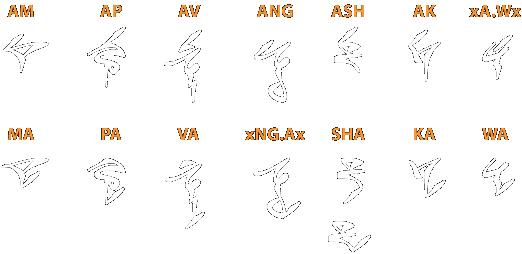
As glyphs have simplified over time the letter (nuhm) for SHo as grown to look very similar to the two-letter combination of O + So (OS). Historically there is no relationship between this upper region of SHo and O, but nevertheless they look very similar today. Many Vulcan teachers are actually fond of this similarity because it gives them an opportunity to teach students to pay very close attention to subtle details. However, there is also a standard convention of optionally writing OS with the O riding on a standard ‘carrier’. This provides a clear visual distinction and avoids any ambiguity.

These so-called ‘carriers’ also come into play heavily when writing prepostions that end in vowel + glottal stop (ʔ: xI’ xU’ xO’ E’ xA’). Common examples:
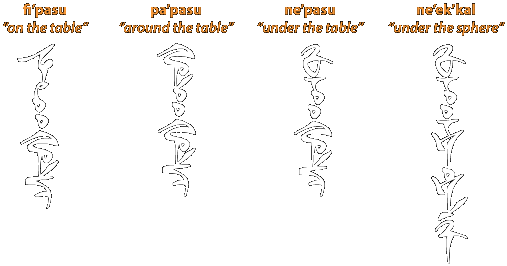
You will see that the carrier is basically the same form as the shala-ralash (glottal stop ʔ), so effectively two small circles occur together. Technically the first is physically connected to its vowel. The 2nd is separated both from the first and typically from the following letter by a small bit of space.
The other scenario in vertical Vulcan writing by hand in which vowel carriers and other vowel variations come importantly into play is common ‘little words’. Note that on the word ni below, there is no carrier, the vowel, I, is simply in its upside down variant.
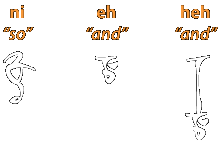
This chart shows the full inventory of all standard handwriting glyphs in the traditional order (Mo, No, oNG, Po, Bo, Fo, Vo, To, Do, Lo, Ro, So, Zo, Tho, SHo, ZHo, TSo, CHo, TCHo, DZHo (Jo), Ko, Go, KHo, Ho, o’o, Yo, Wo, I, IH, II, U, UH, UU, O, OH, OO, OI, E, EH, EE, EI, A, AH, AA, AI, AU) and in the style of neshuk-fek t’sehlat-spahk (sehlat claw pen). They are followed by the numerals 0~9 in the same style.
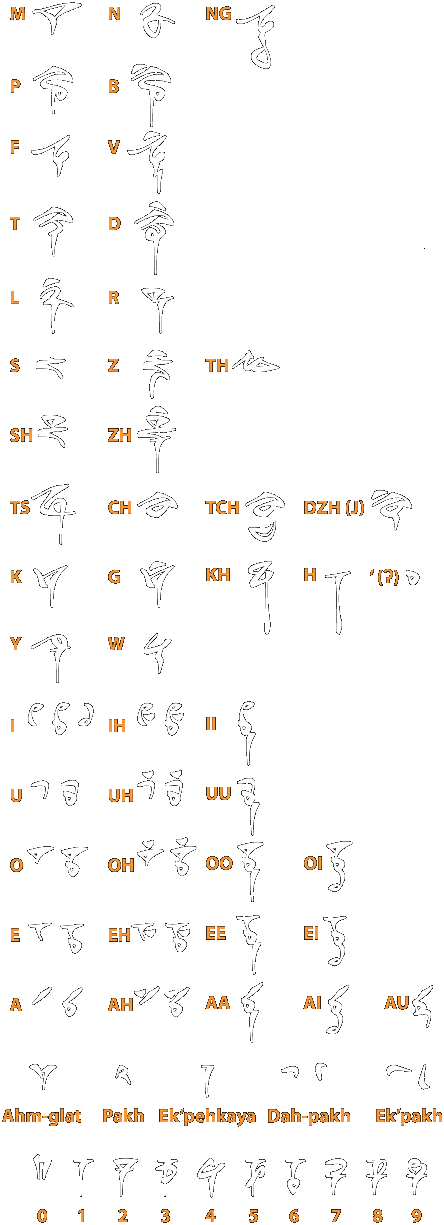
This example shows the two sentences “Stonn killed the le-matya with an antler that he found in the sand after the animal bit his kneecap. It was mid-afternoon.” It is then followed by the numerals 0~9.
It is very easy to see that this type of script bears no design relationship to ceremonial calligraphy. The same text appears in both formats below. They are from two completely different traditions. However, they share the tendency to be more often written vertically than horizontally.
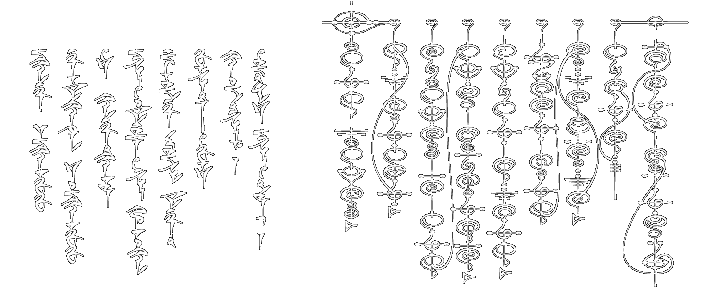
The handwriting glyphs originate from the same traditional system that is sometimes represented on ancient Vulcan dice. But, there is no obvious one to one correlation visually between the two due to the fact that the letters have undergone extensive simplification over time. Stylistically, these letterforms are somewhat similar to the standard script, but do not mimic them directly.

This type of handwriting also appears horizontally and unlike traditional calligraphy does not rotate its glyphs when that occurs. They are simply positioned side by side with spaces between words. However, there are two major stylistic variations regarding the method of writing the vowels. In the most common style, vowels are written as superscript diacritics above the consonants. This is similar to some Indic abugida systems on Terra. The main reason for this is spacial efficiency. Compare the horizontal text above and below this paragraph to see that the preceding style requires less horizontal space than the one that follows. In the independent vowel model, each vocalic glyph rides on a ‘carrier’ in a similar fashion to Korean syllables that begin with a silent ‘ng’.

If having two different systems for horizontal handwriting seems illogical, quite the opposite is true. Vulcan children are taught that logic is not merely some universal correct answer to a question, but rather the concept or discipline of processing the information at hand to make an optimally informed choice. When writing horizontally one must choose the style which is most logical for the immediate task. One must choose overall efficiency over clean, linear simplicity. The correct answer lies only in the mind of the maker of the choice.

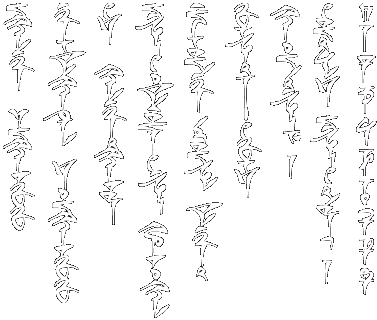

Pingback: El’ru-kitaun • Vulcan Handwriting | korsaya.org
o’Briht’uhn:
I loved this;
“The correct answer lies only in the mind of the maker of the choice”
I’m thinking in a way to write, for beginners; in china paint, we use a design rule, as a support for the right hand. In this way, you don’t have to put your hand over the paper and also, you don’t have to use your hand in ‘free movements’. You only use the free movement -as in cao chinese callygraphy- when you’re a master. I’m trying once and again with ceremonial one… but Snovek cry -and me too, believe me- and I hope to do better with ‘normal’ handwriting. Fascinating, as ever!
Wai’taren!
Dif tor heh smusmah
FA.
I am trying to get a tattoo that reads “To boldly go”, and I saw the Vulcan calligraphy. Would you be able to send me the translation in both the calligraphy version and the hand written version?
oHeather,
I’ll be happy to do that for you. There is also the Modern Standard Script, which does not have its own complete documentation on Korsaya.org yet, but you can see samples HERE. For me to be able to send you the files you’ll require, please send the request via regular e-mail to the address noted on the Contact•Mestau page.
s’Briht’uhn
I’ve been writting a book on Tri-Dimensional Chess Openings….and one of my openings is the Vulcan Opening…..how would you write that. what about other chess related words like check and checkmate? From what i learned V’Tosh is Vulcans so do you link the V symbol this the T, O, SH symbols….exactly how does that work?
Uhgh. I’m afraid I don’t know anything about chess…
Looking at the meanings of the words as they relate to the situations on the boards and adjusting that to a logical, space-faring society, let me offer these possibilities.
Wuhr-Wi’trel = initial puzzle = opening (move)
Pash-Trahkel = ‘setting of the snare’ = check
Pash-Yel-Krup = event horizon = checkmate
V’tosh is a word for ‘Vulcans’. It’s written V.’.T.O.SH where the periods represent separate letters. SH is one letter. It is not native to Golic Vulcan (the language used on this site), but it is canonical, so I’m sure it’s fine for you to use it.
The term wuhr-wi’trel does not specifically have the idea of ‘Vulcan’ (belonging to the Vulcan tradition) in it, but if one were speaking Federation Standard and said, “And the the Cardassian champion opened with wuhr-wi’trel,” I imagine that everyone gathered would understand that was the Vulcan traditional approach. Technically it could be wuhr-wi’trel t’V’tosh, but more colloquially to the experts just wuhr-wi’trel.
If you want me to write these terms out for you, please go find the e-mail on the Contact • Mestau page and send me a request directly via e-mail.
Hi, this page is amazing. Well done.
I’m thinking of getting a tattoo, and I was wondering if there was something poignant that I should get written, cause I really want something in Vulcan. I know this is a random question.
(I was thinking of getting T’hy’la)
oKeyti,
Cha’i t’klem. (Thank you)
If you will e-mail me at the address provided on the Contact • Mestau page, I’ll get you t’hy’la or whatever you like written in the style that you prefer. If the name of your t’hy’la is Chris you could do t’hy’la t’Krihs, for example; meaning Chris’ t’hy’la.
BTW, t’hy’la is spelled “t’hai’la” in the Golic Vulcan scripts.
s’Briht’uhn
hello,
I’m beginning to learn vulcan langage and i must to ask for several point
The first point is about the “C” letter of the vulcan word a’cit (cloth), what is the character i must to use with the Vulcan Handwriting • El’ru-Kitaun
The second point is about the grammar of vulcan langage. where can i find it please ?
during waiting your answer, i continue to learn handwriting.
oT’Pril
It is very agreeable that you’ve taken up the study of Vulcan language.
Let me try to respond to your questions separately:
(1) re: the spelling of a’cit
I must disappoint to say that this is from a Vulcan language that I do not know. I’m not sure which one. The word for “cloth” in the Golic Vulcan language used on this site is sai. Because I don’t know the pronunciation of a’cit, I could only guess that its c would become k, s, ts, or possibly ch in the writing systems presented here. I apologize that I cannot be of more help on this.
(2) re: grammar-focused language lessons
Those can be found either HERE or HERE. The second is basically a reformatted copy of the first.
I hope this is helpful to you.
s’Briht’uhn
Hello, Like Vulcan, I dominate my emotions and sort my feelings, so I am not at all disappointed. I understand that you may not have all the answers I need.
I think for a’cit, C seems close to its K in the English language. a’kit also seems to confer an interesting syntax. However, a’sit also seems appropriate, since C does not exist in Vulcan calligraphy, one can imagine the sound S instead. phonetically, compared to other Vulcan words, this syntax seems to fit and be consistent.
What do you think? because you have to write the word one way or another.
I have not found the link to the grammar, if you can offer me a
Another question comes to mind. prononceriez you how I see the TH pronounced as in Them.
shaya tonat.
T-Pril.
oT’Pril –
Re: The pronunciation and spelling of a’cit, your guess on S vs. K is as good as mine. I simply don’t know.
TH is pronounced as in THING, THINK, THOUGHT. It is like θ in Greek.
These are the overt links to the language lessons I know of. If you are referring to some other grammar, please let me know.
http://home.comcast.net/~markg61/lessons.htm
http://www.stogeek.com/wiki/Category:Vulcan_Language_Institute
Svi’dvin —
s’Briht’uhn
This is fascinating, and the handwriting looks so beautiful. I would love to learn to write like this!
I’m trying to work out why there is no pakh in ‘le-matya’ in your example. What is the reason for that, or is it a mistake?
I’m sure it’s my mistake.
Sanu — Pabukh’voh.
Hi,
Why are there multiple characters for some letters like ‘i’ and ‘o’?
There are multiple letters when the quality of the vowels are different. In the Roman spelling i, ih, and ii are all different sounds. The same is true for o, oh, and oo. Does that answer your question?
This is fantastic. I was wondering though how one would write dashes and apostrophes in words such as tash-tor and yeht’es. I scanned your example paragraph and there are some dashes and apostrophes in there but I can’t make out what part they are or if they’re written in at all. Thanks.
Emily, the punctuation changes depending on the system. If you will request this information by writing to skladan ‹at› korsaya ‹dot› org, I’ll be able to show you more easily. In the handwriting, essentially both are little variations on something almost circular. My apologies for the late reply to your question.
Hi,
I was wondering how do I write Zahal-tor, is it Za hal or Zah al?
Thanks.
Great question! I’m pretty sure it’s ZA HAL-TOR.
Thanks Briht’uhn,
When writing “hi” should I write the “i” with the carrier or without?
And do all the affixes that ends with a vowel should the vowel be written (vertically) with a carrier and without the carrier when horizontally?
One last question… how do we write dates, is there a lesson somewhere I am missing?
This site is so helpful and informative! May I ask, for the Vulcan word “Ashayam,” what would the glyphs be? Would it be “Ash” + “Ai” + “Y” + “Am”? Or would it be “Ash” + “A” + “Y” + “Am”? And would the Ahm-glad precede it if it were being used as a proper noun? (As in the case of being used in a tattoo?) Thanks so much for the work you put into this site!
@ A SH A Y A M (with @ representing the ahm-glat, yes.) A total of 7 glyphs if it is pronounced in the traditional Golic Vulcan way.
This website is so great! I love it! The principles of vulcan writing systems are very innovative in the world of the “invented writing”, usualy it is only modified latin alphabets. So, the writing system presented in this website is based on canon sources for the design thats it? But is not considered as canon by Paramouth etc… However as far as I know of it’s the only one wich have been created for the vulcan, and it suit to them perfectly. I hope that one day someone would create a keyboard system for it! I heard about “microsoft keyboard creator”, maybe using this software it would be possible…
Thank you for the incredible work that you have accomplished on this website!
Thank you for your kind comments. These letterforms are based on or rather “inspired by” non-phonemic, “decorative” writing that was done for the screen for the Star Trek franchise by Mike Okuda and Robert Ware. It would be useful to have a keyboard layout for typing the language “natively”.
Hey, I find this site fascinating and informative. I would like to get a tattoo in Vulcan calligraphy. I like the type that had the flowing lines. Would you be able to write it up and send it to my email? I would like “Logic holds higher value above love and fear, purge the fear and embrace logic as you would embrace life”
Email is dovahkiinmarkov@gmail.com
Jack, you’ll have to send this kind of request directly to skladan /at/ korsaya /dot/ org for me to be able to respond.
This is a great site and im so glad i found it.
Could you please email me with the standard handwriting and traditional script for the word “Diary” or “Journal” as I want it on the front of my new diary i have mad.
I really want to learn Vulcan and I think this site is a great starting point.
Of all the second languages I start to learn it’s Vulcan 😀
My family think im a freak but i think this is a beautiful language i want to learn it.
i eventually want to keep my diary in Vulcan and be able to have a decent conversation in Vulcan.
Ren,
I’m very honored.
Rob,
I am VERY behind on doing artwork for people for tattoos, but the first formal step would be for you to make this request to the e-mail address: skladan /at/ korsaya /dot/ org
I would need to have a regular e-mail address for the delivery anyway.
The word for “diary” is GAD-DUNAP.